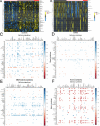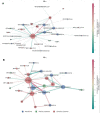This is a preprint.
Host-Microbiome Associations in Saliva Predict COVID-19 Severity
- PMID: 37205528
- PMCID: PMC10187185
- DOI: 10.1101/2023.05.02.539155
Host-Microbiome Associations in Saliva Predict COVID-19 Severity
Update in
-
Host-microbiome associations in saliva predict COVID-19 severity.PNAS Nexus. 2024 Mar 25;3(4):pgae126. doi: 10.1093/pnasnexus/pgae126. eCollection 2024 Apr. PNAS Nexus. 2024. PMID: 38617584 Free PMC article.
Abstract
Established evidence indicates that oral microbiota plays a crucial role in modulating host immune responses to viral infection. Following Severe Acute Respiratory Syndrome Coronavirus 2 - SARS-CoV-2 - there are coordinated microbiome and inflammatory responses within the mucosal and systemic compartments that are unknown. The specific roles that the oral microbiota and inflammatory cytokines play in the pathogenesis of COVID-19 are yet to be explored. We evaluated the relationships between the salivary microbiome and host parameters in different groups of COVID-19 severity based on their Oxygen requirement. Saliva and blood samples (n = 80) were collected from COVID-19 and from non-infected individuals. We characterized the oral microbiomes using 16S ribosomal RNA gene sequencing and evaluated saliva and serum cytokines using Luminex multiplex analysis. Alpha diversity of the salivary microbial community was negatively associated with COVID-19 severity. Integrated cytokine evaluations of saliva and serum showed that the oral host response was distinct from the systemic response. The hierarchical classification of COVID-19 status and respiratory severity using multiple modalities separately (i.e., microbiome, salivary cytokines, and systemic cytokines) and simultaneously (i.e., multi-modal perturbation analyses) revealed that the microbiome perturbation analysis was the most informative for predicting COVID-19 status and severity, followed by the multi-modal. Our findings suggest that oral microbiome and salivary cytokines may be predictive of COVID-19 status and severity, whereas atypical local mucosal immune suppression and systemic hyperinflammation provide new cues to understand the pathogenesis in immunologically naïve populations.
Keywords: COVID-19; inflammatory cytokines; machine learning; network analysis; saliva microbiome.
Conflict of interest statement
Competing Interest Statement: All authors report there are no competing interests to disclose.
Figures




References
Publication types
Grants and funding
LinkOut - more resources
Full Text Sources
Miscellaneous
